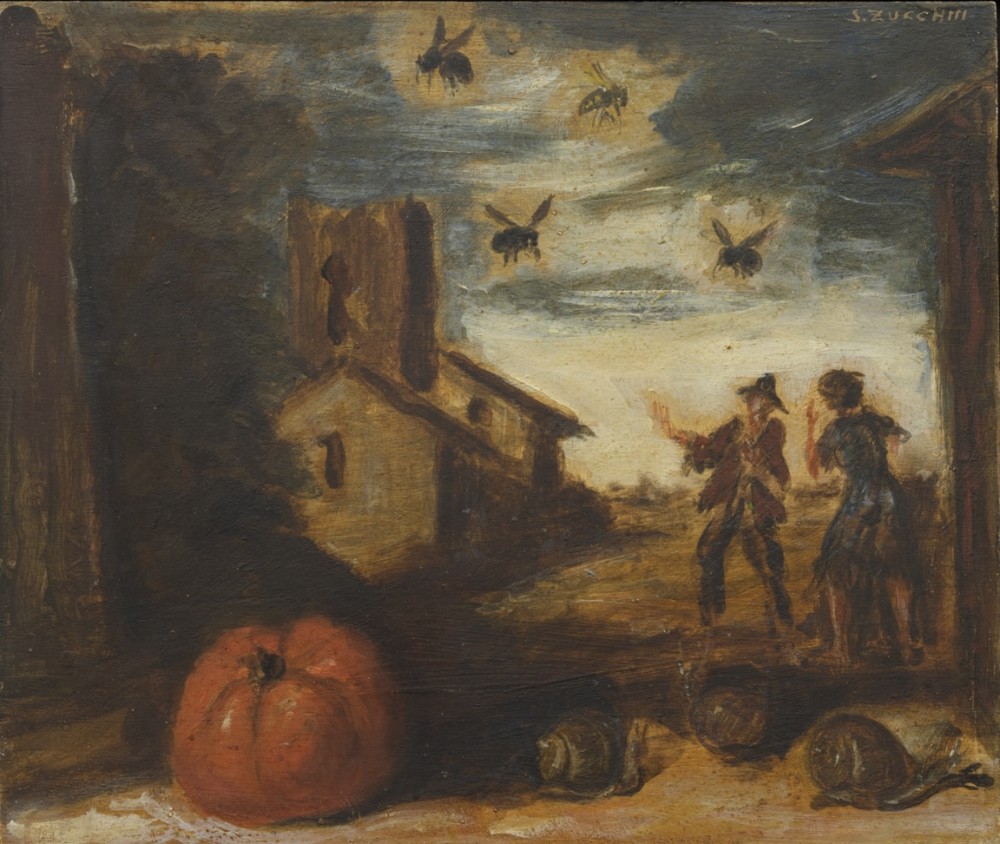
Luigi Zuccheri
Zuccheri’s postwar depictions of rural Northern Italy are at once faithful to naturalistic study and enchanted by an uncanny relationship to scale. The creatures that are the primary subjects of his egg tempera on wood panels have reclaimed the landscape from its flawed human occupants. A brush with Surrealism, an interest in Renaissance ex-voto tablets, and the influence of Metaphysical artists including his friend Giorgio de Chirico inform the paintings on display here. Though Zuccheri had several significant exhibitions in Italy during his lifetime—he was included in the 25th Venice Biennale and had regular solo shows at prestigious galleries in Turin and Milan—this presentation of works made between 1950 and 1955 constitutes the first exhibition of the Italian artist’s work in the United States.
Most fundamental to these lush scenes, however, was the artist’s experience resisting Nazi occupation in Friuli-Venezia Giulia and his resulting status as a fugitive during the final years of World War II. In the conflict’s aftermath, Zuccheri first found consolation in Catholicism, painting ex-votos (devotional works) on the walls of his home and illustrating the writings of saints Francis and Catherine. He soon returned to painting the natural world—a subject he had explored since his late teens. In order to better understand his nonhuman subjects, the artist became an amateur zoologist, exploring the two-hundred-square-mile Venetian Lagoon and its islands in a small sailboat and capturing specimens from which he painted and then returned to their environment.
The early 1950s, however, marked a surreal shift in scale. Using spirited-yet-careful brushstrokes redolent of post-Impressionism, Zuccheri depicted these mammals, amphibians, fish, and insects with rigorous attention to their anatomy and characteristic markings—but their odd proportions within the landscape undermine his studied realism. In one panel (all works untitled, ca. 1950–55), swaths of tempera create a barren landscape of rich umbers into which Zuccheri paints a walnut in between a mouse and a man of nearly equal stature; it is as if the artist has increased the size of the rodent so that he might precisely capture its glinting eyes, fixed on its prized nut, and round ears. The man, in contrast, has no discernable face.
During this period of artistic maturation, Zuccheri gave up the relatively modern practice of oil painting for the ancient medium of egg tempera, studying its techniques in fifteenth and sixteenth century books. By developing his own recipe for the medium, the artist was able to precisely control pigment density, paint thickness, and finish. Though tempera dries quickly and does not lend itself to smooth transitions between hues, Zuccheri embraced its distinctive formal qualities. To render the hare in the foreground of one painting, for example, the artist used a loose, almost Impressionistic cross-hatching technique to blend color. While all of his surfaces are matte, and often feature sections of densely built-up pigment, each retains an ethereal quality that is especially evident in the layers of glaze that constitute his depictions of billowing clouds opening to reveal luminous expanses of sky. Zuccheri’s attachment to the land is evident, too, in his palette—his distinctly muted, sepia-like tones resulted from his practice of grinding his own pigments from stones collected from local shorelines.
These works attest to his attunement to the forms of life that persist even as humans perpetrate violence against their own species. Zuccheri’s larger-than-life animals reveal his desire for nature to retake a landscape tainted by the social machinations of fascism. His scenes are depicted from the perspective of their creatural inhabitants, rather than those who seek to tame and exploit them. In one painting, a peasant trundles through the middleground, seemingly oblivious to the snake, beetle, and mushrooms that populate the fore. In another, slate-gray clouds part as if by some divine intervention to reveal a bright, clear sky that reflects in shimmering strokes on the lake and banks below it. A diminutive figure bends down to peer into the glassy water while another prepares to fish. In the composition’s bottom register, turtles and fish evade the threat of the hook’s snag as they move through the waves, undisturbed.